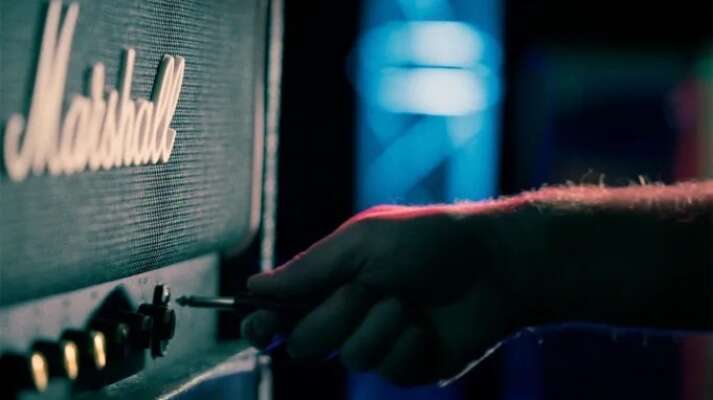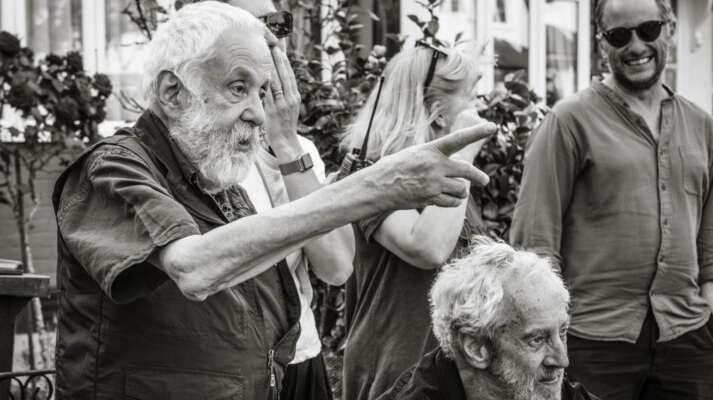The Spirit of Chicago
How the Second City became a star in What They Had
The Spirit of Chicago
Written by Peter Bowen
After Ruth (Blythe Danner) wanders out one night into a snowstorm without any sense of where she is going or what she is doing, her family is forced to face some hard facts about her failing health. Her daughter Bridget (Hilary Swank) flies back to Chicago from Los Angeles with her daughter Emma (Taissa Farmiga). Bridget's brother Nick (Michael Shannon), who owns a bar downtown, wants to send his mother into a facility dealing with memory loss. And Ruth's husband Bert (Robert Forster) wants her to stay at home with him in their Hyde Park apartment, a comfortable, familiar place filled with memories of their life in Chicago.
Having grown up in Chicago until the age of 14, Chomko felt setting her movie there was essential. "Chicago is a character in the film-geographically and culturally," she explains. For a story inspired by the experiences of her family, Chomko felt that shooting in Chicago was necessary to frame those memories. Even more, the specific perspective of Chicagoans fueled the dramatic conflict at the center of her tale. "Traditional Midwestern morality is centered around loyalty-to your family, your faith, and your parish," explains Chomko, who used that sense of loyalty "to hang a story around the challenges of caregiving-how do you put your head down and do the right thing when there is no right thing?"
A Chicago state of mind
"Writing the script and then shooting in Chicago felt like a long-lost homecoming," exclaims Chomko. "It's still the only place I feel is truly home." To capture the world she knew, Chomko mapped out the actual locations and experiences that returned her to her childhood: "Maywood racetrack, Kiddieland (now a Costco), Peterson's Ice Cream in Oak Park, getting Italian beef at Johnnie's or lemon ice from Freddy's." While the production was unable to incorporate all these spots into the final film, "they gave our team the sense of regional texture I was after," explains Chomko.
From the start, however, Chomko emphasized that the film's Chicago was more an emotional space than an actual urban location. "Given that the film was inspired by memory," she explains, "we wanted the film-particularly the Chicago sequences-to feel like a memory: grounded in realism, but heightened." Working with her cinematographer Roberto Schaefer, Chomko crafted a filmic look that used special lenses to create "a feeling of nostalgia" through pronounced focal aberrations. She stresses, "We made the colors more saturated, the light more stylistic, the images more composed, certain sounds more pronounced like clocks ticking and the whistle of the trains." In so doing, the film provides a portrait not only of Chicago, but also of the woman at the center of the story. "Much of the Chicago sequencing was inspired by Ruth's point of view, our notions of what life might look like in her mind," notes Chomko.
Shooting Chicago
To spotlight Chicago, the production strategically chose their locations. Ruth and Bert's apartment is in Hyde Park, an established multi-cultural neighborhood that is the home to the University of Chicago and other historically notable institutions. The exterior to their family church was Hyde Park's First Unitarian Church, which has been rebuilt many times since being established in 1836. The interiors, however, were from the Old St. Patrick's Catholic Church in West Adams, one of the few structures to survive the Great Chicago Fire of 1871.
To signify "Chicago" to audiences, Chomko relates how she and her producer Bill Holderman "spent three sleepless days with a small but dedicated crew capturing the city and its outskirts dressed for Christmas-the Lakefront, Water Tower, Michigan Avenue, the Merchandise Mart, and Soldier Field lit with red and green." While the story called for snow, nature didn't help out for most of the shoot. "We got a surprise snowstorm in the early morning of our last day and drove out to the O'Hare [airport] at 5 AM to capture it," recalls Chomko. "Having this footage proved critical," she adds. "It gave the film its only real snow and authentic sense of place and time."

For the initial scene of Ruth wandering down a Chicago street in winter, the production team had to manufacture the snow. For production designer Chris Stall, this was an essential cost. To emphasize how Ruth and Bert's apartment was the emotional heart of the story, he chose a warm color palette that cools down considerably elsewhere. "Once you leave the parents' bedroom things get colder and colder," explains Stall. "That is why the snow was such an important element…her wandering out into the night in the snow is her metaphorically wandering out from the heart of the family." For Chomko, Chicago winters are very particular. "The light is different, the sky is heavier, [and] the snow brings out both the adult and the kid in you," she explains, adding, "We were inspired by the magic of breath hanging in the air, how cozy and comforting it is to be warm indoors, how exposed and vulnerable you are when you're not."
The other locations had similar emotional resonances. For Nick's bar, the production used the Argentinean restaurant Folklore in Wicker Park, shutting off the restaurant section in order to focus just on the bar. By keeping the action in a single-room bar, the production team created, according to Stall, "an almost cage-like feeling with the panes of windows" in the front.
Cinematic Chicago

In popular film, Chicago has played many characters. It has been transformed into the crime-ridden Gotham City in Christopher Nolan's epic films Batman Begins and The Dark Knight and a dystopian future in Neil Burger's Divergent. It brought back the good-old bad days of Al Capone in Brian De Palma's The Untouchables. In John Hughes' teen suburban universe, Chicago looms as the big city to the south in classics like Ferris Bueller's Day Off, and as a locus of young love in such romantic comedies as My Best Friend's Wedding, High Fidelity, and Never Been Kissed.
For a short period in the early 20th century Chicago became a Midwest Hollywood. In 1907, the Chicago-based Essanay Studio put out over 2,000 short films. Having lured Charlie Chaplin to the studio with a big cash incentive, they produced 15 of his films, including his 1915 classic The Tramp (which was shot in Essanay's California studio). While most mainstream film production dried up in Chicago by the 1920s, a new business, African American films, found a home in Chicago for a short time. William Foster's 1912 The Railroad Porter is considered one of the first films with an all African American cast. Later acclaimed African American film pioneer Oscar Micheaux founded his production company in Chicago, releasing his 1919 feature film The Homesteader there.
Despite the presence of nationally acclaimed playwrights and theaters, not to mention comedy troupes like The Second City, few films were shot in Chicago until the 1980s. In shooting in Chicago, What They Had also showcases its talents. Michael Shannon not only lived in Chicago but is also a seminal member of its theater community. He is a founding member of Chicago's A Red Orchid Theater and has performed at such theaters as Steppenwolf, Lookingglass, Northlight, and the now closed Famous Door. "The movie is a love letter to my hometown of Chicago, and I wanted to capture its texture," Chomko says. "Michael has that in spades."
In addition, the film reflects the city's unique ability to be a major metropolitan area that feels like a small town. Stall, who'd never worked in Chicago before, was amazed by how comfortable and friendly the city was. "When you get there and start exploring all these neighborhoods that feel like tight-knit communities, it started to feel like a small town to me," remembers Stall. "I really grew to love Chicago."


